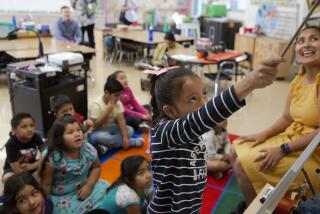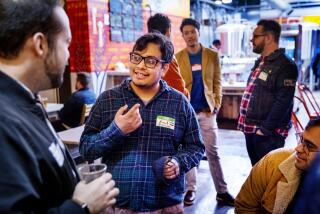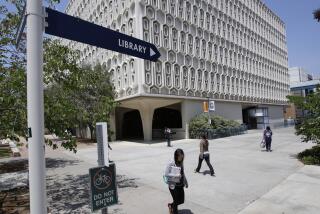How COVID-19 and budget woes have changed what ‘back to school’ means at Cal State
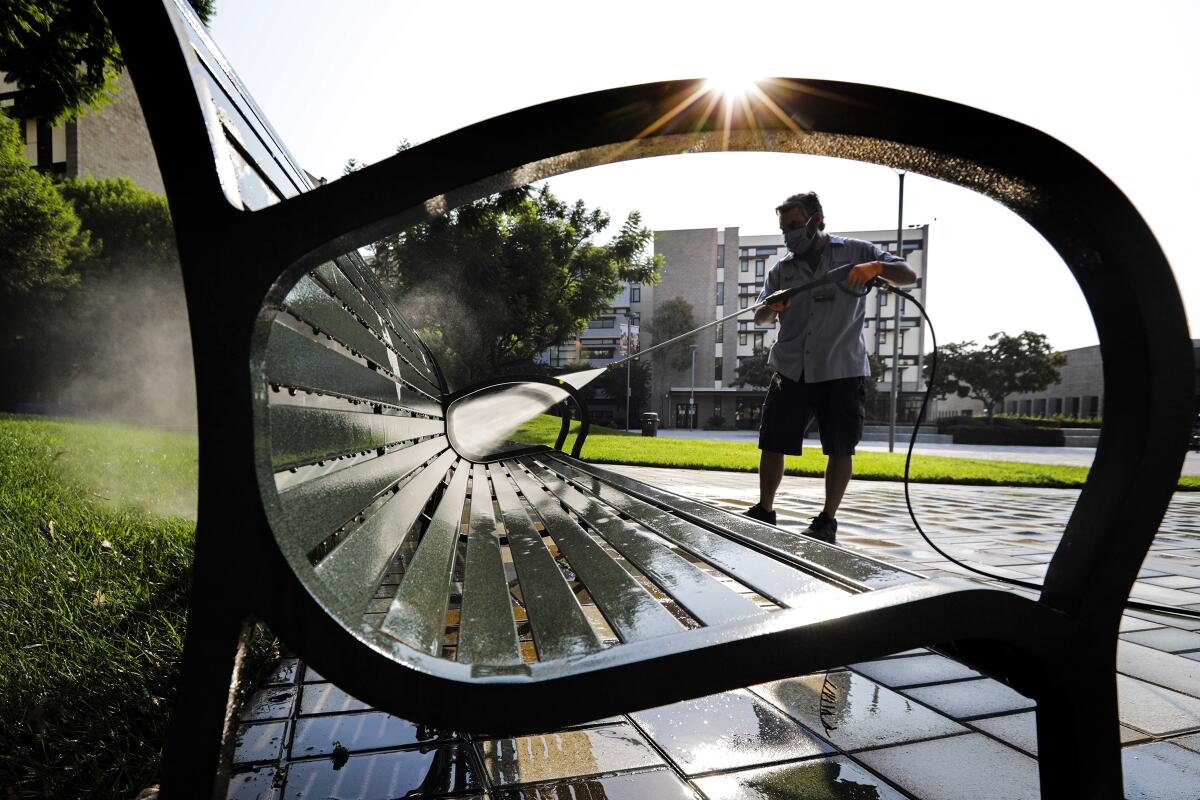
As 480,000 California State University students prepare to log on for the start of a new academic year, the coronavirus crisis has produced uneven effects throughout the system on enrollment, budgets and even the number of students permitted to take in-person classes.
Some campuses, particularly in the north, are struggling with enrollment, while in the south campuses see little to no change. Budget cuts have some universities considering layoffs and course reductions, while others are holding steady. And with 23 campuses in 18 counties, some colleges will offer more in-person classes and services than others.
At Cal Poly Pomona, for instance, just 2.5% of course sections will offer in-person components, including courses held off campus. Fewer than 500 students will live on campus. Cal Poly San Luis Obispo, in contrast, will offer 13% of sections in person, and as many as 5,980 students — 70% of capacity — will live on campus.
Los Angeles County, which has a relatively high prevalence of COVID-19, has issued strict reopening guidelines for higher education institutions, whereas San Luis Obispo, which has half the case rate per 100,000 people, has said it would follow the somewhat more relaxed state guidelines.
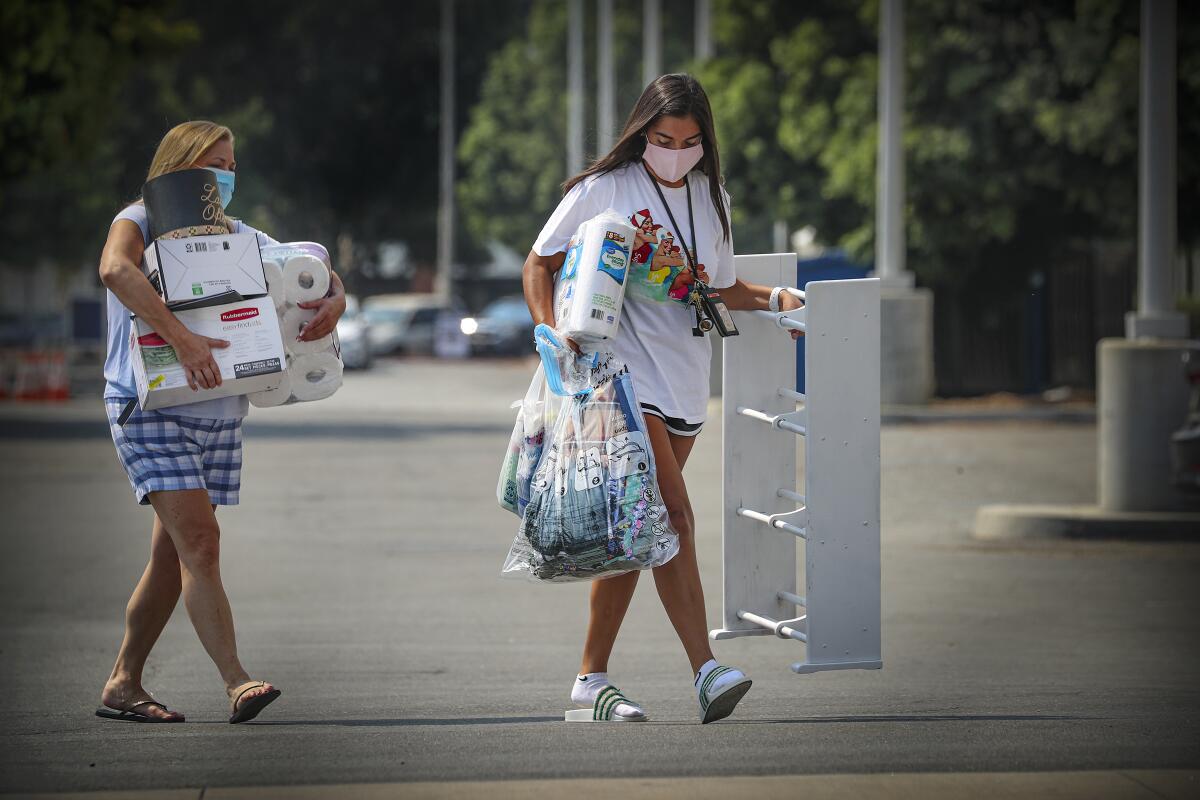
CSU Chancellor Timothy White signed off on all 23 campuses’ plans.
“They vary based on the geography of the campus, they vary based on the facility footprint,” White said at a recent online forum hosted by the nonprofit news organization CalMatters. “Small cramped classrooms are different than great, big open spaces.... Something that cannot happen on one campus might be happening on another campus.”
The Cal State system was one of the first to announce, in May, that it would begin the fall semester almost entirely online. Days later, Gov. Gavin Newsom proposed a 10% state budget reduction to all three systems of public higher education in California, prompting campuses to grapple with how to make cuts.
All of the L.A.-area CSU campuses — Dominguez Hills, Fullerton, Los Angeles, Long Beach, Northridge and Pomona — say they are projecting steady enrollment compared with a year ago. With about half their revenue coming from tuition and fees, that ensures some stability, though campuses are still limiting travel, freezing hiring and laying off some employees.
“I am confident that we will deliver the same level of service to our students in the classroom and outside the classroom as we have delivered in the past,” said President Framroze Virjee of Fullerton, the system’s largest college and one of its most competitive. “I don’t know that we will be able to do that in future years, but for this year I am sure of it.”
Virjee added that his college, which expects to exceed last fall’s enrollment of 39,868, has no plans to cut classes.
Itzel Delgadillo, who is studying business administration and public relations at Fullerton, moved back in with her parents in Lamont, Calif., after the pandemic hit. The first member of her family to attend college, she was used to focusing only on school and her part-time job managing a Little Caesars restaurant.
But at home, she’s expected to help with cooking and cleaning. She shares a room with her sister and doesn’t have a desk, working from the dining table or a bed instead.
“That’s the roughest, just not having a desk,” she said. “As a student at Cal State, I’m used to having a library or a Starbucks and my own space, my own room. Now I don’t have that controlled environment.”
Despite the difficulties, she said she wouldn’t return to campus even if it were an option. Delgadillo and her sister recently spent two weeks quarantined in their room, recovering from COVID-19.
“I know how it is and I know who it can affect, and I wouldn’t risk my family and I wouldn’t risk other people’s health,” she said.
In L.A. County, only classes that train students in essential work, such as healthcare, education, and food and agriculture, may meet in person, and only students with no feasible alternative may be housed on campus.
At Cal State L.A., where enrollment is on target around the 26,000 students who attended last fall, fewer than 100 students will live on campus and only six clinical nursing courses will be offered in person.
At Cal Poly Pomona, enrollment numbers are also steady, at about 27,000. Almost all classes, with the exception of graduate research or thesis projects that cannot be conducted virtually, will be remote, leading to one of the lowest rates of students on campus of any Cal State school.
“We had a really high bar — higher than even those among the other CSU campuses,” said Sepehr Eskandari, associate provost for academic planning and faculty excellence. With its focus on “inclusivity” and equity, that meant rethinking how the university offered remote instruction.
“We had not paid enough attention to the digital divide” before the pandemic, said S. Terri Gomez, associate provost for student success, equity and innovation.
To correct that, Pomona created a lease-to-own laptop program, trained faculty in distance education over the summer, and embedded more tutors and teaching assistants in classes.
At some Northern California campuses, the picture looks somewhat different.
Long reliant on students from outside their regions to bolster enrollment, these campuses were experiencing enrollment declines before the pandemic.
“The growth in demand for the CSU has been largely in Southern California,” said President Lynn Mahoney of San Francisco State, where enrollments have been dropping for years, in part because of the high cost of housing. “The Northern California campuses have had to work harder.”
Amid the uncertainty of COVID-19, many students are electing to stay closer to home or enroll in community colleges. San Francisco State is expecting a 10% drop in overall enrollment, including a 33% drop in its freshman class — the latter of which Mahoney attributed entirely to the pandemic.
“The number ... sounds huge,” she said, “but it’s not an existential crisis.”
It does mean, though, that revenue will drop. The university will reduce some lecturers’ loads and cut back on courses, giving priority to general education and major requirements, advising and counseling, Mahoney said. It will also lay off employees according to its collective bargaining agreement, but not full-time faculty.
With just over 1% of classes being offered in person and almost all other services moved online, Mahoney estimates there will be few students on campus, which blends into the city of San Francisco.
Farther north, at Chico State and Humboldt State, which are projecting enrollment declines of about 7.5% and 12%, respectively, officials plan to open up more of their campuses to students.
Located in more rural Butte and Humboldt counties, these campuses offer hands-on training in agriculture, forestry and oceanography that can be hard to translate online. Many students live on or near campus, where they contribute significantly to local economies.
Chico State will offer in-person learning for about 10% of all course sections; at Humboldt State, the figure is closer to 13%.
Chico State officials said that once Butte County comes off the state’s coronavirus watchlist, the campus will open some student activities, with modifications. In Bell Memorial Union, conference rooms will house student services such as the Dream Center and Gender and Sexuality Equity Coalition, and the bookstore and cafe will be open. Some study spaces will be available by appointment, but students must socially distance. The school’s 800-acre farm will be open.
So will off-campus sorority and fraternity houses, where university employees have volunteered to hang leaflets reminding residents about safety during the pandemic.
“We knew our students were going to come back anyway,” said Sandy Parsons, Chico State’s interim vice president for student affairs. “Either we figure out a way to engage them appropriately and safely, or it won’t go well.”
Breanna Holbert, an agriculture major and the Associated Students president at Chico, has remained throughout the pandemic at the off-campus house she rents with three other students.
“From a student standpoint, of course I want these things to be open because I’m paying for them,” she said of student services.
But as a Black Latinx individual whose parents have preexisting conditions, she doesn’t think she’ll use them much.
“I have family members who could be impacted and infected and potentially die because I went into this building,” she said. “I don’t feel comfortable doing those things.”
More to Read
Start your day right
Sign up for Essential California for news, features and recommendations from the L.A. Times and beyond in your inbox six days a week.
You may occasionally receive promotional content from the Los Angeles Times.
